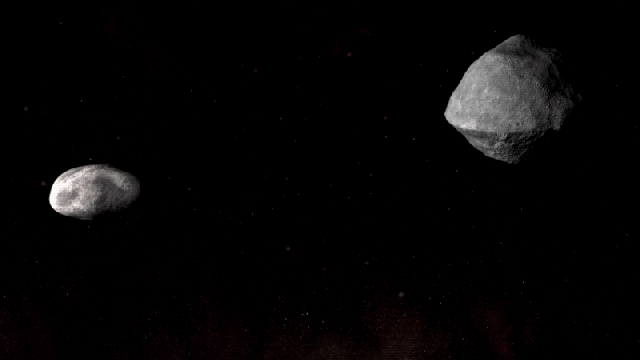A mission to demonstrate an asteroid deflection technique just got a NASA promotion to the design phase. Called DART, the plan would see a refrigerator-sized spacecraft smash into a non-threatening asteroid, causing it to move ever so slightly from its original orbital path. The project is seen as an important first step in developing a planetary shield against incoming asteroids.
DART, which stands for Double Asteroid Redirection Test, is being designed by scientists at the Johns Hopkins Applied Physics Laboratory, and it will rely on the “kinetic impactor technique”, whereby a fast moving spacecraft will smash into a Near Earth Object (NEO), causing it to gradually shift its orbit. Eventually, the tactic could be used to nudge an asteroid that’s headed straight for Earth.
In what will be the first demonstration of its kind, DART will be tested on the smaller of two non-threatening asteroids in the Didymos system. The two asteroids in this binary pairing are known as Didymos A, which measures about 780m in diameter, and Didymos B, which is about 160m wide. NASA is hoping to smash a spacecraft into Didymos B in 2024. These rocky objects are similar in size and composition to many asteroids, including those that could wreak havoc on Earth.
“A binary asteroid is the perfect natural laboratory for this test,” said Tom Statler, program scientist for DART at NASA Headquarters, in a statement. “The fact that Didymos B is in orbit around Didymos A makes it easier to see the results of the impact, and ensures that the experiment doesn’t change the orbit of the pair around the Sun.”
For the mission, DART would fly to Didymos and use an autonomous onboard targeting system to aim itself at Didymos B. The refrigerator-sized spacecraft would strike the smaller asteroid at about 6km/s, which is about nine times faster than a bullet.
To the naked eye, this celestial collision won’t appear as much, but Earth-based observatories should be able to measure the resulting change in the orbit of Didymos B around Didymos A. Even a small nudge should have an impact on its orbital trajectory, which will become more obvious over time.
Importantly, DART will allow scientists to better determine the effects of such impacts on asteroids, and the data gleaned from this mission could inform future efforts — including a mission to deflect an actual Earth-bound asteroid. This test will let scientists know how heavy and fast a kinetic impactor needs to be, or how many kinetic impactors might be required to sufficiently move a single target.
“DART is a critical step in demonstrating we can protect our planet from a future asteroid impact,” said DART co-leader Andy Cheng from the Johns Hopkins Applied Physics Laboratory. “Since we don’t know that much about their internal structure or composition, we need to perform this experiment on a real asteroid. With DART, we can show how to protect Earth from an asteroid strike with a kinetic impactor by knocking the hazardous object into a different flight path that would not threaten the planet.”
Moving the project from the conceptual stage to the design stage is no guarantee this mission will actually happen, but it’s an important next step. Regardless, it’s encouraging to know a planetary shield is in the nascent stages of development.
